To be transparent in the workplace is to stay true to the principle of open communication in every possible situation. No matter how challenging and uncomfortable it may be, the benefits of transparent communication are hard to ignore. When you readily share information and ask teammates to participate in decision-making, you send out the message that their opinion and their presence are important and valued. This results in a positive, relaxed, and genuine work environment, conducive to productive and innovative efforts.
In this article, we will take a closer look at the meaning of the term “transparent communication” — the elements that compose it, and some examples to help give us a clearer picture of it. We’ll then follow up by explaining the benefits of transparent communication, and what a workplace looks like without it. Finally, we will give you ten tips you can use to promote transparency in your organization, also illustrated with examples.

Table of Contents
What is transparent communication?
Transparent communication is the type of communication where both positive and negative information is shared upward, downward, and in a lateral manner, according to the definition provided by Michigan State University.
And what does it mean to be transparent in the workplace? It means that you provide the three elements of transparent communication when interacting with your peers, subordinates, and supervisors. According to research, these elements are:
- Disclosure of information — you publicly reveal all legally accessible information, explaining the internal processes of the organization.
- Participation — you involve stakeholders into decision making processes.
- Accountability — you remain accountable for your actions and decisions.
When all three of these elements are properly implemented, you provide the necessary conditions for open and transparent communication.
What are examples of transparent communication?
What does clear and transparent communication actually look like? To get a clear understanding of the topic, here are a few transparent communication examples:
🔶 Example 1: Netflix implements the practice of “sunshining” — encouraging executives to explain their decisions in public. Whether it be matters of firing people or increasing the executives’ salary, employees are expected to stick to the principle of “radical transparency”.
🔶 Example 2: In a large cross-functional team, the representatives of each department are expected to provide thorough updates of what their department is working on, and to what end. In other words, this company is attempting to eradicate team silos, and induce free information flow.
🔶 Example 3: transparent communication can also be upward, directed from regular employees to their supervisors. The following example shows one such interaction, where Christofer uses a team messaging app to ask his boss — Stella, for more regular meetings.
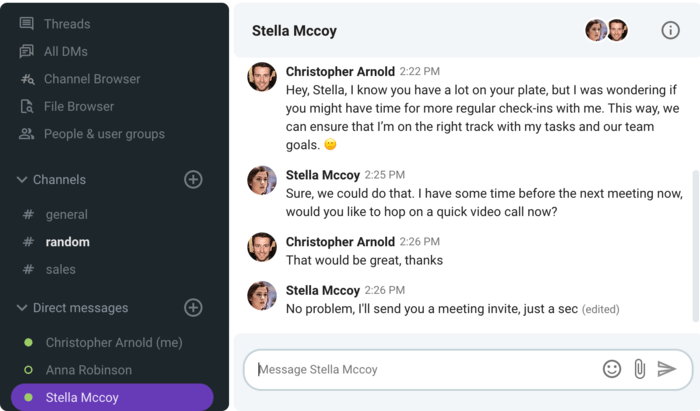
Why transparency is important in communication at work
Exploring the impact of authentic leadership and transparent communication, one study showed that the organizations that are readily sharing information with employees, and encouraging employees to participate in and criticize company processes manage to develop a favorable reputation among employees and beyond.
Further on, transparent communication in business is the #1 factor that contributes to employee happiness.
As seen in this TINYpulse survey, the correlation coefficient of transparency and employee satisfaction is 0.94 — meaning that they practically necessitate each other.
As to exactly why transparency improves company reputation and employee happiness, reasons include the following:
- Transparent communication builds mutual trust — by being open and forthcoming, we evoke a sense of trust, which further helps establish deep and authentic relationships.
- Transparency helps employees better cope with organizational change — studies found that when trust is established through transparency, people are also more likely to better accept and cope with organizational change.
- There is more space for eager innovators to express themselves — according to research, there’s a direct link between transparency and the innovative effort and efficiency of a company.
- People feel valued, so they’re more likely to be engaged in the workplace — when authentic leaders take on the task of being transparent in their communication, it’s been shown to lead to work-life enrichment, and consequently to improvements in levels of employee engagement.
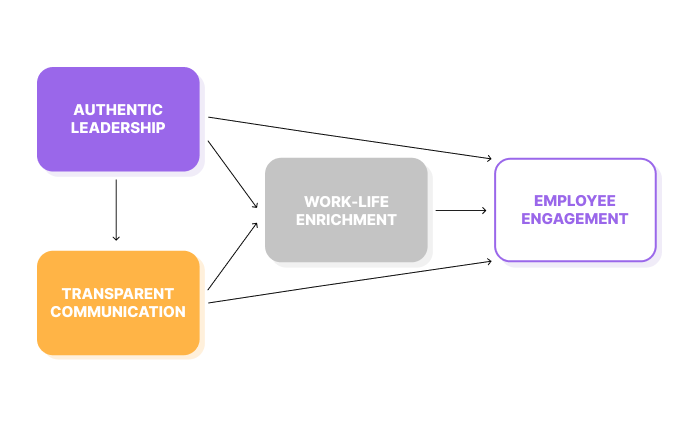
💡 Pumble Pro Tip
How do authentic leaders communicate? Find out in our article on
What does a lack of transparency in communication do to a workplace?
When little thought and effort is put into transparency, the work environment becomes a stressful and toxic place. The lack of transparent communication results in micromanaging, gossip, information blockages, and a lack of employee engagement.
Micromanaging all day long
The first symptom of a work environment lacking in transparency is micromanaging. It’s caused by a lack of clear rules, and expectations, and a hesitant attitude towards sharing information concerning internal processes. This way, people are pushed to overcompensate with control.
Micromanagement is one of the surest ways to sink employee morale affecting 68% of employees who have experienced micromanaging. In addition to this, 55% of people also reported that micromanaging negatively affected their productivity.
Gossip is rampant
When there are no clearly defined, transparent communication channels, people resort to gossip for information-sharing. And where there’s gossip, there’s miscommunication, judgment, and the lack of an objective, broad perspective of the situation. Over time, gossip transforms into the main manner of communication, creating a toxic and stressful work environment.

💡 Gossip is to be expected in all places where many people interact with each other, including a business environment. Check out our article focused on How to manage grapevine communication in your team for tips on how to deal with it.
No engagement: “nothing ever changes, so why bother speaking up?”
When there’s no transparency in the workplace, employees might take up the attitude of non-engagement, due to a sense of futility. In other words, perhaps they’ve tried to communicate their feedback to their superiors in the past, only to be met with disinterest, a lack of will for action, or even rage for questioning authority. This is a sure-fire way to make employees disengage, and withdraw from any attempt at providing constructive feedback.
How do you promote transparent communication — 10 tips
To give you an outline of how to go about promoting transparent communication in your work environment, we’ve compiled this list of ten tips:
- Build trust by showing vulnerability;
- Balance expressing empathy and respecting privacy;
- Use technology to provide a direct channel of communication;
- Be clear about your values;
- Provide stability, stay consistent;
- Avoid jargon, use words everyone can understand;
- Share real-time updates;
- Explain why you can’t share what you can’t share;
- Set up your space to be more welcoming;
- Don’t go overboard: avoid the transparency trap.
Let’s dive in for more details!
1. Build trust by showing your human side
We’re all human and we all have our flaws. However, in a business setting — and especially when you have a leadership role — it’s hard to admit failures and faults. We want to be seen as perfect, fearing that otherwise, people won’t respect us. The truth is, the genuinely strong and confident leaders are able to be vulnerable with their team members. When people see the authentic, human side of us, they are more likely to trust us and to feel comfortable with transparent communication.
🔶 Example of building trust by showing vulnerability:
Timothy is a sales lead in an international company. The company recently missed a big opportunity for collaboration with an important client. In a team meeting, Timothy takes responsibility for the failure, explaining how his actions have been misguided. His other team members, who were worried about repercussions now see his human side, and now trust him to be a good leader. In the future, this trust manifests itself in more open communication.
2. Balance expressing empathy and respecting privacy
People will feel more comfortable sharing information and experiences with you if you regularly show empathy for their issues. This, of course, improves transparency — but be careful not to get too personal when asking questions. There still needs to be a line separating work and private life, to avoid being pushy and overbearing.
🔶 Example of balancing empathy while respecting privacy:
One of Harry’s team members says they cannot attend a meeting due to personal matters. As the team leader, Harry has the authority to say “No”, or to punish the person for not providing an adequate explanation. However, he chooses to be understanding and respect this person’s privacy, by not asking further questions and not pressuring them to attend the meeting.
3. Use technology to provide a direct line of communication
General invitations for transparent communication come off as too vague. Instead, you should focus on establishing direct lines of communication, which employees can use to provide positive and negative feedback. This is where modern communication tools come in handy — making room for simple and instantaneous communication.
🔶 Example using technology to provide a direct channel of communication:
Sienna is the marketing VP of a fitness supplies company. She decides to create a channel in Pumble — the team messaging app her team uses, with the intention of encouraging more transparent communication. As we can see below, it’s called “#ask-questions” and its purpose is for team members to ask each other any questions they might have during work hours.
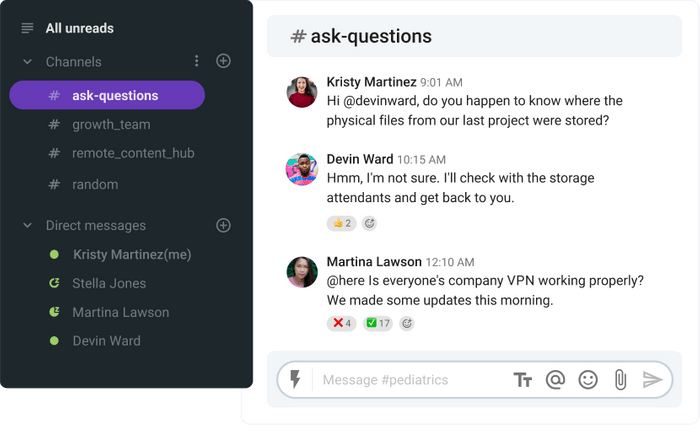
4. Be clear about your values
Regular reminders about company values are one more way to enable transparency in the workplace. Sarah Hawley — CEO and Founder at Growmotely and the author of “Conscious Leadership” — gave us advice on how she and her team go about this:
“Know your values and what you stand for as an organization, and talk about these things regularly. Each week we reflect on what we’re celebrating as a team. and each month in our All Company meeting we go through our vision, purpose, and values and then share stories of where people have lived out our values. For us, our values really define our culture, they are what’s important to us and how we show up for each other.”
🔶 Example of being clear about values:
As the HR lead, Isabella wants the company employees to stay in touch with the principal company value of trust at all times. To foster it, she decides to instate “Worry-sharing Tuesdays”, where people are encouraged to share situations from work where they’ve felt uncertain and anxious. This way, they are reassured that struggle is a normal part of the work experience, and that it’s not something anyone will hold against them.
5. Provide stability, stay consistent
Erratic behavior can quickly cause people not to trust you. When you insist on transparency one day, and you seemingly forget about it the next, this is a signal to people in your environment that the words you say don’t carry too much weight. This results in a strained relationship, where no one is sure how to communicate with each other. So, to prevent this, be consistent with what you say and do.
🔶 Example of providing stability and staying consistent:
Mike makes it a point to always carefully consider feedback he gets from his subordinates, be it good or bad. As the team leader, he feels responsible for providing employees with a solid and stable foundation on which to build transparent communication.
6. Avoid jargon, use words everyone can understand
The overuse of jargon and technical terms can alienate other people, who perhaps aren’t familiar with them to the extent you are. Essentially, you’re talking to yourself, with your team members feeling inadequate and talked down to. It’s better to use simpler, more widely recognized words, in order to bridge the gap of knowledge people with varying levels of experience and different departments have between themselves.
🔶 Example of avoiding jargon:
Instead of saying “We need to implement a Net Promoter Score query into our beta version of the app”, Adam — the marketing lead — decides to simply say: “We should include a question in our beta version of the app, asking people how likely they would be to recommend our product”. This way, everyone in the room has a clear understanding of what he said, whether they have a marketing background or not.
💡 If you think you could benefit from tips on what phrases to use in a business setting, go ahead and take a look at our article on Business communication words and phrases: what to use and what to avoid.
7. Share real-time updates
As we mentioned in the first segment of this article, one of the key elements of transparent communication is — disclosure of information. So, there’s no transparency if there aren’t frequent, real-time updates. The best way to do this is to use real-time communication technology, or, when possible — to organize daily face-to-face meetings. If sharing updates as soon as possible becomes your daily habit, other employees will appreciate your effort to keep them in the loop.
🔶 Example of sharing real-time updates:
Here’s one example of a manager sharing important updates, concerning protocols around asking for time off — and here is how this matter should be communicated. John, the manager of a marketing team, uses Pumble’s #general channel to notify all employees of the updates to this process.
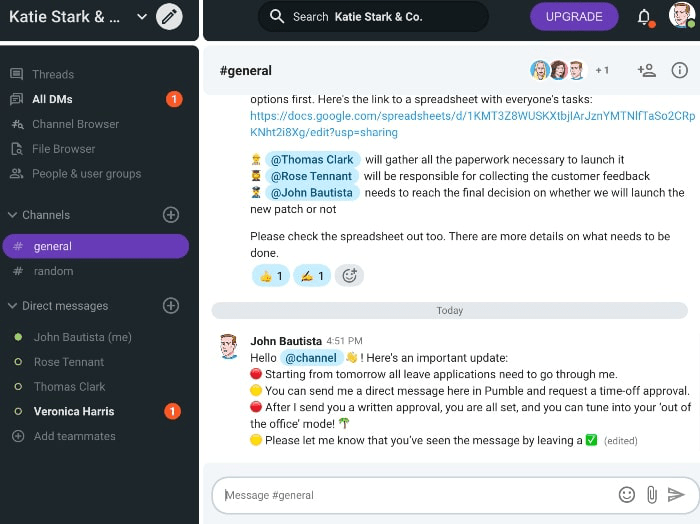
💡 You might be struggling with sharing information in a productive way. If you are, you might be interested in this article that explains How to share information effectively in a remote setting.
8. Explain why you can’t share what you can’t share
There’s always a limit to what information you can share — confidentiality is important in highly-complex company processes. This means that, from time to time, you will have to deal with questions from employees that you aren’t permitted to answer. Approach this issue in a tactful manner, by explaining to your coworkers why you can’t share the information they’re interested in. This way, you relay to them that you would be happy to share this information, if there weren’t important reasons behind why you cannot do so. If possible, try to provide a broad idea of these reasons.
🔶 Example of explaining why you can’t share some information:
Due to privacy concerns, Jenny — the project manager — cannot share the identity of their client with the rest of the team. Even though keeping everyone in the dark is exactly the opposite of what she usually does, this situation requires it. She tactfully informs her team members as to why it’s important for this project to remain confidential, all the while reassuring everyone that it won’t interfere with their work.
9. Set up your space to be more welcoming
The room where you conduct meetings is important for setting the tone of the conversation. For example, you’re sitting behind a huge desk in your comfy chair, while the person you’re talking to is awkwardly shifting in a creaky plastic chair. The power dynamic is clearly not in their favor, so they are bound to feel uncomfortable. As a result, they are less inclined to communicate freely and openly. The simple solution to this is to make your space more welcoming, by including decorations, putting up family photos, and making other changes that make the space feel more warm and pleasant.
🔶 Example of setting up space to be more welcoming:
Daryl — the CTO of an e-commerce company — noticed that, despite his “open-door” policy, people were reluctant to come in and talk to him. He decides to redesign his office to give off a more welcoming ambiance. Immediately, he sees a shift in how people behave during meetings, as well as noting an increase in the number of people willing to provide feedback.
10. Don’t go overboard: avoid the transparency trap
The term “transparency trap” was coined by Ethan Berstein, writing for Harvard Business Review. He uses it to describe the situation where too much transparency accomplishes results contrary to what was intended by it. In essence, going overboard with information of how people spend their time, understandably makes them apprehensive and feeling exposed. The solution — as it commonly is — is to find a balance between too much and not enough transparency.
🔶 Example of avoiding the transparency trap:
One of the suggestions at a board meeting discussing making improvements to transparency in the workplace was to rearrange the space in an “open” way. However, this suggestion was dismissed after several people noticed it would interfere with employee privacy, putting everything everyone does on complete display.
Pumble promotes transparent communication
Transparency is crucial for efficient collaboration and healthy team communication.
Pumble, as one of the best team communication apps promotes transparency in workplace communication.
First, thanks to Pumble’s unlimited message history, you can always check previous direct messages or posts in channels.
Also, you can download and send documents or files of any size.
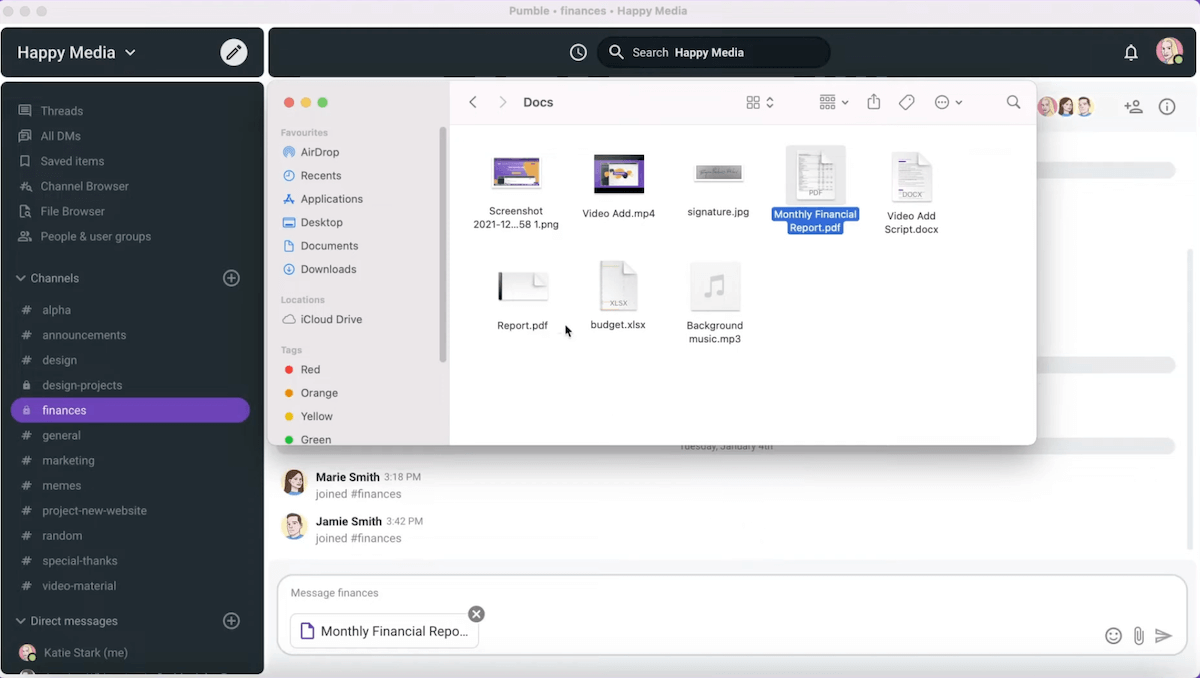
Secondly, you can give guest access to people outside your organization and have transparent communication with third parties as well.
Finally, if you prefer to see or hear professionals you talk to, you can always schedule voice or video calls and even share your screen while on a video call.




